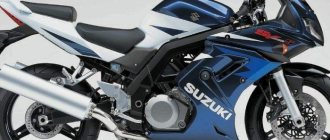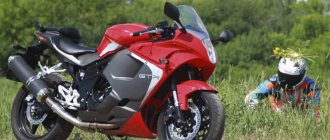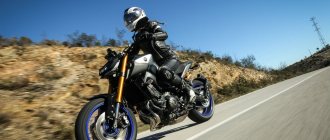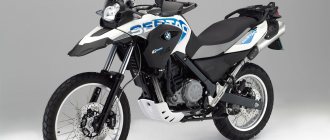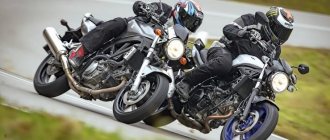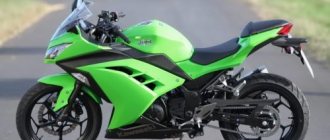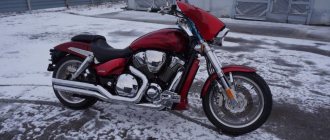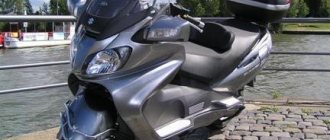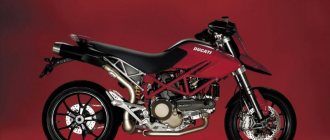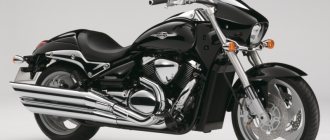Review of the Suzuki V-Strom 1000 (DL 1000) motorcycle
I was driving and felt - this is it! Comfort, speed, sound, handling. . ugh!!! It is mine!!! And landing! You sit high! The back is straight and does not get tired! Hands on the steering wheel - comfort, no fatigue! Changing lanes is easy and precise. Handling is wonderful. In general - delight! And the engine is big! This power at low speeds responds jerkily if the gas is unscrewed carelessly, but this is a matter of habit and settings. I think this “bug” will be eliminated over time. Also, I liked driving at night! I didn't like it much before. And I don’t like driving. And here! The light of the “chandelier” illuminates the road clearly and clearly. . it’s light And because of the landing, you see exactly what is illuminated by the headlights. In general - wonderful!!!
Comfort, speed, sound, handling. . ugh!!! It is mine!!! And landing! You sit high! The back is straight and does not get tired! Hands on the steering wheel - comfort, no fatigue! Changing lanes is easy and precise. Handling is wonderful. In general - delight! And the engine is big! This power at low speeds responds jerkily if the gas is unscrewed carelessly, but this is a matter of habit and settings. I think this “bug” will be eliminated over time. Also, I liked driving at night! I didn't like it much before. And I don’t like driving. And here! The light of the “chandelier” illuminates the road clearly and clearly. . it’s light And because of the landing, you see exactly what is illuminated by the headlights. In general - wonderful!!!
I drove 600 km over Saturday and Sunday. 150 km on Thursday evening and Friday evening. Total - 750 km. Summary. A motorcycle for traveling far, easily and comfortably! The consumption is low, the engine is torquey, the wind protection rules, the saddle is a waste.
Further operation showed that a heavy enduro, such as this sofa on two wheels, should be primarily used for movement on asphalt roads and light off-road conditions a la “packed country roads” - it will be difficult to ride through the mountains and climb in the mud, because it weighs 230 kg dry condition. add here gasoline, trunks with luggage, a rider and we get a car weighing 400 kg. And it is a car, because a speed of 200 is achievable for it and is not very stressful.
add here gasoline, trunks with luggage, a rider and we get a car weighing 400 kg. And it is a car, because a speed of 200 is achievable for it and is not very stressful. Adjusting the windshield allows a 175 cm tall pilot to completely hide behind it and ride in complete comfort and bliss. In general, if you travel far and don’t want to walk like a cavalryman after the next section of the run, then this is the motorcycle for you.
Adjusting the windshield allows a 175 cm tall pilot to completely hide behind it and ride in complete comfort and bliss. In general, if you travel far and don’t want to walk like a cavalryman after the next section of the run, then this is the motorcycle for you.
So, Suzuki DL1000 V-Strom (Storm) Adventur 2012, mileage 300 miles, engine capacity 996 cc, power 98hp, V-twin engine, 6-speed gearbox. Seat height 840 cm. Weight 240 kg. Previously I was the proud owner of a V-Star650, which successfully exchanged a V-Strom.
Before I settled on Storm, I climbed a bunch of sites, read reviews, and decided on the criteria. Storm - it is a liter, with a comfortable fit, with luggage bags (trunks), but the main problem was its saddle height of 840. I am not particularly tall at 170 cm. and I was very worried whether I would be able to reach the ground with my feet =)) in the end I reach the ground with half of my foot (toes), this makes me happy, because I can hold and push the bike.
I’ll tell you about my first impressions of the trip. Engine starting is preceded by a Check; the engine starts with the clutch depressed (a feature of all Suzukis). The exhaust is pleasantly pleasing due to the presence of a V-shaped twin - a dull rumbling gives way to a menacing roar when unscrewing the throttle. gears are switched on clearly, neutral is caught even from the first (unlike Star, where the neutral was switched on only from the second). The dashboard has a tachometer, temperature, gasoline gauge, the odometer has two modes (general and trip), and there is a clock on the dashboard, which is also convenient. The handlebars are quite high, which makes the landing almost straight with a slight tilt forward. There is hand protection so that the wind does not turn your fingers into ice. The windshield, unlike the Star, is quite low, but surprisingly, the wind doesn’t blow a bit away, apparently the glass is configured in such a way that the air flows above the driver. So, I set off from ExtremeMoto and drive in the traffic along Bryansk 2, catching up with the car, clicking gears first, second…..I lower my eyes to the speedometer…100ka…, surprisingly long 2nd gear, and the speed is not felt at all. In general, I slowed down and was driving third in the traffic. Since the engine had not been run-in, I did not turn the engine above 4000.
in motion the motor is generally as light as a 125 =)) and another thing that made me go nuts is the acceleration... in comparison with a 650 drag, this is actually something, just hold the steering wheel, otherwise it will jump out. I drove to the garage, said good night to my new friend and went home. The positive impression was further reinforced by the presence of two original side cases, which can be easily removed by turning a key. There is also a central textile back bag, which is also very comfortable, it has a whole bunch of different pockets and there is a plastic insert inside so that it keeps its shape. The bag can be easily removed and installed, and is attached to straps with Velcro.
I wanted a NEW universal car that could drive in the city, clear traffic jams, maintain cruising speed of 140-150 on the highway, not be afraid of our roads and potholes, could drive off the asphalt and crawl a little along a country road.
I looked at the Honda Transalp and was put off by the price, soft suspension and carburetor. I looked at the Honda Varadera - a good motorcycle for everyone, but 1.5 times more expensive than the Susa. I looked at the KTM - well, it’s not very good, IHMO, it’s comfortable in the city, there’s no speed on the highway, no vibration, no price. In short, the car costs more than the show-offs... TyGyDym (TDM-900) - scared away by the age of the design. After all, he is almost a grandfather...
After the break-in, I began to look at what kind of beast I got... Power and torque - POWER! It pulls great already from 2500 rpm; on the highway, if 6th gear is engaged, then it is better not to drop below 3800-4000. Handling in the city - I’m very happy with the second-hand car after Transalpa. At speeds the motorcycle is stable up to 170 km/h. Then begins an easy walk along the motz track and the front wheel “bounces”. Maybe it's because of the rear case...
Adjustable windshield - there are three positions, but I still haven’t chosen which one is better... In the lower one - it blows in the face. In the upper area behind you, turbulence begins. Average is a compromise between turbulence and howling wind in your ears. This is how I drive with the glass in the middle position, but I will experiment with the automatic layout. What I really don’t like is NO protection for the knees from air currents. If there is wind, cold and rain, then the knees die first. Such is the aerodynamics of the motsa. It also spits streams of water right into the shoes when driving through puddles. Transalp did not have such vile habits!
In the upper area behind you, turbulence begins. Average is a compromise between turbulence and howling wind in your ears. This is how I drive with the glass in the middle position, but I will experiment with the automatic layout. What I really don’t like is NO protection for the knees from air currents. If there is wind, cold and rain, then the knees die first. Such is the aerodynamics of the motsa. It also spits streams of water right into the shoes when driving through puddles. Transalp did not have such vile habits!
I tried to play with the suspension, but returned to the factory settings. Here I showed laziness and would be glad to collect opinions on who has what settings. On the highway, if you keep it at 130-140, then the bike with coffee and a load consumes 6-7 liters per hundred. But if you drive 170-180 or torn mode, then 10L don’t surprise you.
In general, despite the listed shortcomings, I really like the Mots and am quite happy with it as a UNIVERSAL means of transportation.
Suzuki V-Strom 1000 – TEST
2014 onwards, 1037 cm3, 99 hp,
228 kg, 210 km/h, RUB 539,900.
text: Vladimir Zdorov
photo: Evgeny Bobrikov
In the photo: Vladimir Zdorov
>>The world of large touring enduros is diverse and amazes with the sophistication of its representatives, who, in the endless arms race, have long and firmly “settled” at around 150 hp. And some particularly advanced examples can easily ruin the nerves of more than one owner of a sportbike on the track!.. Just like there are specialists in the field of off-road, in the case of an experienced pilot they are quite capable of quickly moving on real off-road conditions. However, not all manufacturers strive to keep up with fashion - in particular, the management of the Suzuki concern has its own vision of the concept of a flagship touring enduro, which was implemented in a slightly different format than its competitors... In the V-Strom 1000 format
Out of format
The synergy of the big name does not correlate with reality: 99 hp. in the context of modern ecophobia, this is a very relative value. Stifled to meet the increasingly stringent requirements of the “green” engines, the V-Strom engine is unlikely to capture the imagination of even very moderate, if you like, conservative motorcyclists. The situation is approximately the same with the new design - although it noticeably moves the car away from the retro forms of its predecessor, created before the October Revolution, but it is unlikely to deserve an Oscar in the “Best Design” category. With great desire and imagination, you can see parallels in the past with such a legendary motorcycle as the SuzukiDR750, also known as “Doctor Big,” but, alas, that’s where all the space-time bridges end.
However, there is no point in discussing the mistakes of marketers: the new V-Strom was deliberately created in exactly this format. In fact, this is a large touring motorcycle, or more precisely, a completely road motorcycle, designed as an enduro for touring. So that future owners have no illusions about its off-road potential, just look at the pampered asphalt wheels, so similar to those on Suzuki sportbikes of the early 2000s, which, by the way, easily take on various geometric shapes even on the streets of the capital. The complex shapes of the exhaust system in cooperation with the oil filter, causing concern for its safety even when in contact with a small curb, are also some kind of overture, but not off-road.
Among the pleasant and new things worth noting are two-level traction control, a low seat for an enduro (850 mm), a very comfortable driver’s position, Brembo radial brake calipers and 310 mm diameter discs (oh, Gods, it looks like Atlantis has been resurrected somewhere, and Suzuki has appeared a model with quite adequate, effective braking mechanisms, which feel like they work much better than on most of the company’s sportbikes!). The impression is slightly spoiled only by the scanty and frail windshield, which is not saved even by the possibility of adjustment in three positions. As usual, there is a solution - a higher fairing, for additional euros...
The old and not at all kind engine in the past, which Suzuki has been mercilessly exploiting since 1997, in its best times produced 135 hp when it was installed in the SuzukiTL1000R frame. However, in modern reading, the engine is no longer the same. Despite a slight increase in displacement (from 998 cm3 to 1037 cm3) due to a slightly larger cylinder diameter, as much as 36 hp were mercilessly sacrificed to “His Majesty the Torque.” Not without a heavier stator, “humble” camshafts and other inquisitorial essays from the engineers.
Indeed, a solid torque makes itself felt already from 3,500 rpm... but all this riot and extravaganza of acceleration colors ends already at 5,500 rpm! Everything that follows is a sad contemplation of beauty... Show me a modern large-capacity touring enduro that “dies” after 170 km/h and barely reaches the speedometer up to 210 km/h? Although, what am I talking about? That's right - for 99 hp. the results are quite expected...
But if you abstract from a priori unpromising comparisons with the Top line of other manufacturers and try to plunge into the philosophy of Suzuki, then everything will fall into place. The engine of the new V-Strom is in complete harmony with the precision-tuned chassis: no, no electronic suspension adjustments, like much more expensive opponents, are offered on the V-Strom 1000 even as an option, but... they are not needed. Firstly, for particularly offensive “athletes”, it is possible to adjust the suspension in the good old mechanical way. And, secondly, even in stock, the motorcycle has a very collected, Nordic behavior on the road, more likely reminiscent of a good naked bike than a larger enduro.
Taking into account the fact that already after 3,500 rpm the driver has more than 80% of the total torque at his disposal, you can “hang” in sixth gear after reaching 80 km/h and forget about switching for a long time. It is important to note that this nature of the power plant allows you to almost not notice the additional load in the form of a passenger and luggage - if we talk about a motorcycle from a tourism point of view, then this is certainly a valuable quality. By the way, one of the definite advantages is the amazing efficiency of the V-Strom: even the most aggressive driving style did not allow me to “make” more than 8 liters per 100 km! If you move in the modes in which most sane travelers travel, then it is quite possible to get something in the region of 6 l/100 km...
Perception
So, what did the Japanese, as wise as three dozen owls, finally put together under the new name Suzuki V-Strom 1000? Budget (yes, first of all, it’s really the most “tasty” option among opponents in price, “killing” even KawasakiVersus!), comfortable (especially if you replace the standard bikini fairing), with good handling, a motorcycle capable of long trips on asphalt in enduro form. Why “in character”? Because no matter how much and how you attach off-road tuning to a motorcycle, the whole thing will rest on alloy wheels (the company does not offer spoked options at the time of publication). In other words, as soon as such an option appears, it will be possible to talk about a more accurate fit into the term “enduro”. True, no one can cancel a modest ground clearance and an oil filter along with pipes dangerously close to the ground.
To the quite reasonable remark that 99% of V-Strom 1000 owners will travel exclusively on asphalt, it is quite reasonable to note that the same Suzuki has much more interesting models for traveling on asphalt. By the way, with a quite comparable price. Yes, the model can be equipped with all the accessories of a real off-road master and, if desired, even come up with something with spoked wheels... This version of the V-Strom will be called... BMWR1200GS / YamahaXTZ1200 / HondaVFR1200XCrosstourer / KTM 1190 Adventure (underline as appropriate). The price will be something similar, only minus the hemorrhoids and the time it takes to install all the necessary ingredients.
Despite the technical complexity of implementation, Suzuki uses a dual ignition system in the V-Strom motorcycle engine. A gasoline internal combustion engine works by igniting the fuel-air mixture, and the spark plugs are responsible for “igniting the conflict.” A standard spark plug works due to a voltage pulse with an amplitude of ~25 kV and a duration of ~1–2 ms applied to its electrodes. The high temperature of the spark discharge plasma ensures local ignition of the fuel mixture and forms a flame front moving through the combustion chamber. In turn, the flame front is a narrow zone of the medium, without sharply defined boundaries, in which combustion occurs. The thickness of such a layer, taking into account the pressure in the cylinder, is a fraction of a millimeter. Thus, if we decompose the process of explosion of the fuel-air mixture in an engine cylinder in time, we can see that at each moment combustion occurs only in a small part of the chamber, exerting an asymmetrical effect on its walls, which creates additional losses due to the “shifting” of the piston. To optimize combustion geometry, engineers use complex mathematical models and measurement systems when designing engines—for example, special spark plugs with fiber-optic sensors that allow them to “look” inside a running engine. On some production engines, Suzuki uses a rather simple but effective method: by installing a second spark plug in the combustion chamber and applying a high-voltage pulse to it with a slight delay relative to the first, you can obtain a flame front that is close to symmetrical, which reduces losses in the cylinder-piston group and increases combustion efficiency fuel. An additional advantage of this approach is increased reliability of the ignition system. If the spark plug, ignition coil or output transistor of the engine control unit fails, the cylinder will continue to operate, and the driver will notice the malfunction only thanks to the Check Engine indicator. The use of a similar engineering solution on the Suzuki V-Strom provides approximately a 5% increase in power - this is not difficult to verify by using a dynamometer and temporarily disconnecting the second spark plug.
Suzuki DL 1000 V-Strom
Brief review of Suzuki DL 1000 V-Strom
The touring enduro Suzuki DL 1000 V-Strom is a heavy motorcycle designed for long-distance travel, well adapted to any road surface. Its impressive weight and high seat height make it not very suitable for hard off-road conditions, but a powerful engine (a modified engine from a Suzuki TL 1000 sportbike), good suspension and developed wind protection made this model very popular among fans of long-distance motorcycle travel. This model is built on the same base as the Suzuki V-Strom 650. It is also produced under the Kawasaki brand and under the name Kawasaki KLV 1000 (differences - different wings, different coloring, different windshield).
The V-Strom 1000 was upgraded several times throughout its production, and was not produced from 2009 to 2013. The first modernization was carried out in 2003 - the motorcycle received a different seat, the ability to adjust the fork pretension and a reinforced clutch basket. Since 2004, the windshield has been adjusted, in addition, the gearbox has been slightly modernized, and a new dashboard has been installed on the motorcycle. Since 2006, the V-Strom has been equipped with upgraded oil injectors. In 2009, the model was removed from the assembly line, but since 2013 its updated version has gone on sale, with new suspensions, a new engine and other differences.
Similar motorcycles:
- Honda XL 1000V Varadero
- Honda CRF 1000L Africa Twin
- Yamaha XTZ 1200 Super Tenere
- Kawasaki Versys 1000
- Aprilia Caponord
- Kawasaki KLV 1000
- Triumph Tiger Explorer
- BMW R1200GS
Technical characteristics of Suzuki V-Strom 1000
- Years of production: since 2002
- Class: touring enduro
- Frame: diagonal alloy
- Engine: 4-stroke, 2-cylinder, V-shaped
- Engine capacity, cubic meters see: 996 (since 2013 - 1037)
- Cooling: liquid
- Valves per cylinder: 4
- Fuel supply: injector
- Power: 98 hp at 7600 rpm (since 2013 - 100.6 hp at 8000 rpm)
- Torque: 101 Nm at 6400 rpm (since 2013 - 103 Nm at 4000 rpm)
- Maximum speed, km/h: 200
- Acceleration from 0 to 100 km/h: ~3.9 seconds
- Transmission: 6-speed
- Wheel drive: chain
- Front tire: 110/80-19
- Rear tire: 150/70-17
- Front brakes: 2 discs 310 mm, 2-piston calipers (from 2013 - 4-piston), ABS
- Rear brakes: 1 disc 260 mm, 1-piston caliper, ABS
- Front suspension: telescopic fork (since 2003 - with pretension adjustment); since 2013 - inverted fork with a full range of adjustments
- Rear suspension: adjustable preload and rebound monoshock
- Gas tank volume, liters: 22 (since 2013 - 20)
- Fuel consumption at 110 km/h, liters: ~5.4
- Curb weight, kg: 236 (since 2013 - 228)
Pros and benefits of the Suzuki V-Strom 1000
- Advanced wind protection
- Energy-intensive pendants
- Comfortable standard seat
- High ground clearance
- Excellent dynamics
Pros and cons of the Suzuki V-Strom 1000
- Heavy weight
- High center of gravity
- High seat height
- High fuel consumption at high speed
